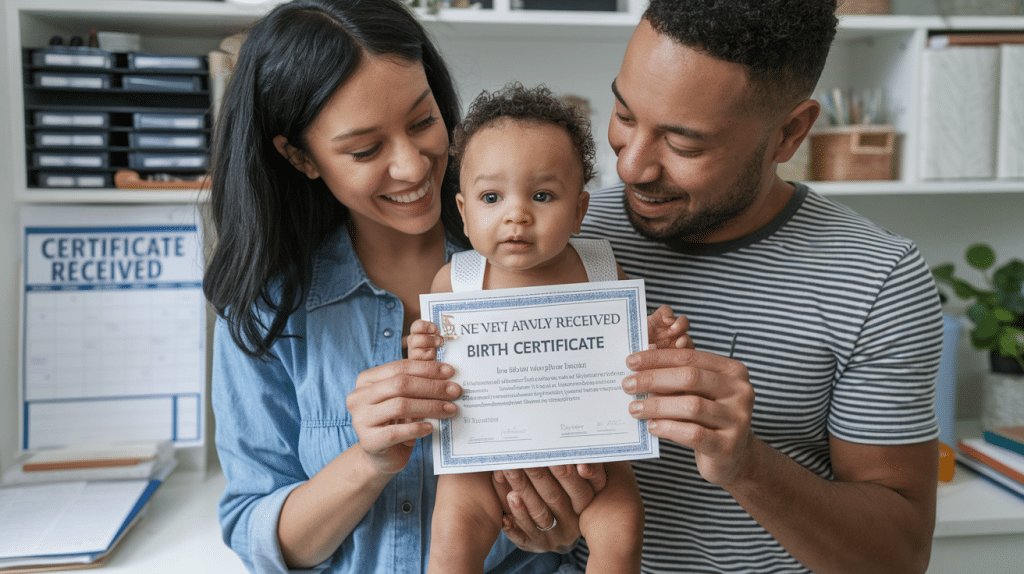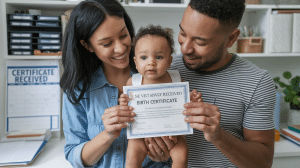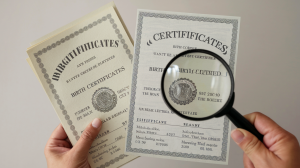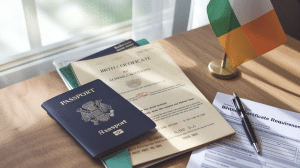Ever stood in a government office with a crying baby, only to realize you’re missing half the paperwork needed for their birth certificate? Been there. It’s a special kind of parental nightmare that ranks right up there with explosive diapers at fancy restaurants.
Getting a birth certificate for your child shouldn’t require a detective license, yet parents everywhere find themselves confused about what documents they need to get a birth certificate. The requirements can vary wildly depending on where you live.
I’ve helped hundreds of new parents navigate this paperwork labyrinth, and I’ve spotted the exact shortcuts that make this process painless. But here’s what most official websites won’t tell you about those “standard requirements”…
What You Need to Provide

Required Documents for Birth Certificate Applications
Getting a birth certificate for your child shouldn’t be a headache, but you’ll need to have your ducks in a row before you apply. Here’s what you’ll typically need to provide:
Proof of Identity
You can’t just walk in and ask for a birth certificate without proving who you are. Most vital records offices require:
- A valid government-issued photo ID (driver’s license, passport, or state ID)
- If you’re not the parent, you’ll need documentation showing your relationship to the child or legal authority
- Some states accept secondary forms of ID if you don’t have a photo ID
Birth Information
The basics about your baby need to be documented:
- Full name of the child (as it will appear on the certificate)
- Date, time, and place of birth
- Sex of the child
- Hospital name (for hospital births)
- Birth weight and length (in some jurisdictions)
Parent Information
Both parents matter here:
- Full legal names (including mother’s maiden name)
- Dates and places of birth for both parents
- Current addresses
- Social Security numbers (optional in some states, required in others)
- Marriage certificate (if applicable)
Application Forms
Each state has its own paperwork:
- Official birth certificate application form (varies by state)
- Notarization may be required on some forms
- Some states have separate forms for hospital births vs. home births
Keep in mind that requirements can vary significantly depending on your location. Some states have additional requirements for unmarried parents, adoptive parents, or surrogate births. It’s always smart to check your specific state’s vital records website before gathering your documents.
How to Order

In-Person Application Process
Getting your child’s birth certificate in person is often the fastest route. Head to your local vital records office, health department, or county clerk’s office. Bring your ID and your wallet—there’s always a fee involved, typically between $15-30 depending on your state.
The big advantage? You might walk out with the certificate that same day. Some offices even offer expedited services if you’re in a rush.
Online Ordering
Most states now offer online ordering systems that make the process painless. Sites like VitalChek are authorized by most states and can save you a trip to the government office.
The online route is perfect if you’re too busy chasing your toddler around to make it to an office during business hours. Just remember that processing times are typically 2-3 weeks, and you’ll pay a bit extra for the convenience (around $5-10 more than in-person).
Mail-In Applications
If you’re not in a hurry, mail-in applications work just fine. Download the form from your state’s vital records website, fill it out completely, and include:
- A photocopy of your ID
- A check or money order for the fee
- A self-addressed stamped envelope
Mail everything to your state’s vital records office and wait about 4-6 weeks. It’s the slowest option, but sometimes it’s the most convenient.
Third-Party Services
Various companies can handle the entire process for you—for a premium, of course. They’ll charge anywhere from $50-100 but take care of all the paperwork and follow-up.
These services are worth considering if you’re overwhelmed with new-parent duties or facing a complicated situation like ordering from another state.
Certified copies of birth certificates available – suitable for legal purposes.
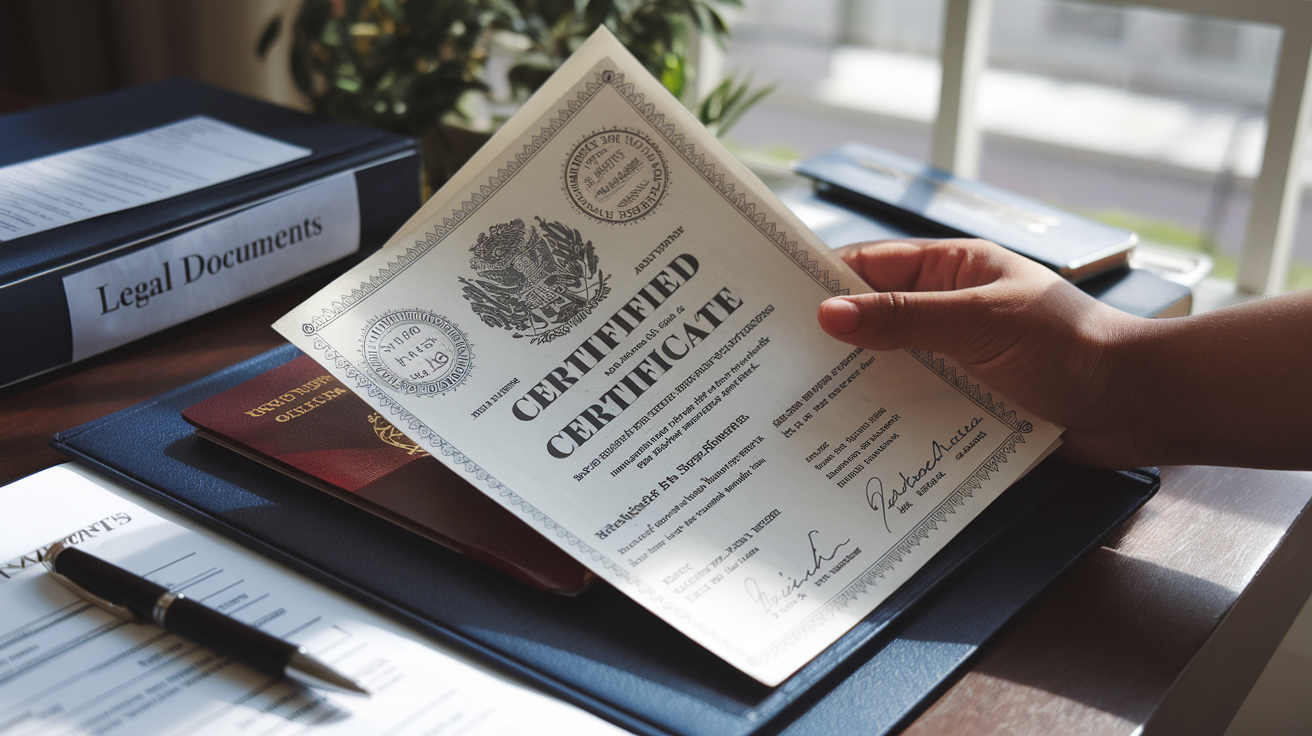
What is a Certified Birth Certificate?
When it comes to your child’s birth certificate, not all copies are created equal. A certified birth certificate is an official copy that bears the registrar’s raised, embossed, impressed or multicolored seal, signature, and the date it was filed with the registrar’s office. This isn’t just a photocopy – it’s the real deal that government agencies recognize.
Think of it as the difference between a photocopy of a $100 bill and an actual $100 bill. Only one of them can buy you groceries.
When You’ll Need a Certified Copy
Your child will need this certified document throughout their life for:
- Getting a passport
- Enrolling in school
- Obtaining a driver’s license
- Applying for Social Security benefits
- Sports registration that requires age verification
- Getting married (seems far off, but time flies!)
How to Identify a Certified Copy
Not sure if what you have is certified? Look for these features:
- A raised, embossed, impressed, or multicolored seal
- Official signature of the registrar
- Date it was filed with the registrar’s office
- Printed on security paper (often with a watermark)
- Usually has the state or county seal
How Many to Order
I recommend ordering at least 2-3 certified copies initially. They’re typically cheaper when ordered in multiples right after birth. Having extras on hand saves you from emergency requests later when you’re rushing to meet a deadline for school enrollment or passport applications.
Resources

Government Websites
Looking for the most reliable source for birth certificate information? Your state’s vital records office website is your go-to. Every state has their own official site with downloadable application forms, fee schedules, and processing timelines. Most have switched to user-friendly designs that walk you through the exact steps needed for your situation.
The CDC’s National Center for Health Statistics also offers a directory of all state vital records offices. One click and you’ve got phone numbers, physical addresses, and website links for every state. Super handy if you’re not sure where to start.
Community Support Organizations
Many hospitals partner with local organizations that help new parents navigate the paperwork jungle. These groups often provide free assistance with birth certificate applications, especially for families facing language barriers or financial challenges.
Look for family resource centers, community action agencies, or nonprofit legal aid organizations in your area. They might offer workshops or one-on-one help with completing forms correctly the first time.
Mobile Apps for Document Management
Several apps now help you track important documents for your child. Apps like Sortly, Evernote, and Google Drive let you scan and store copies of your child’s birth certificate and other vital records.
Some states have even developed their own official apps for ordering vital records. These secure platforms often process requests faster than traditional mail methods.
Online Forums and Parent Groups
Sometimes the best advice comes from other parents who’ve recently gone through the process. Sites like Reddit’s r/Parenting or BabyCenter forums have threads dedicated to birth certificate questions.
Local Facebook parent groups can be goldmines for state-specific advice. Parents often share which offices have shorter wait times or which methods worked best for their situation.
Forms

Birth Certificate Application Forms: What You’ll Need to Fill Out
Getting a birth certificate for your child involves paperwork—there’s no way around it. But don’t stress! The forms aren’t as complicated as they might seem at first glance.
Most states use a form called the “Certificate of Live Birth” or “Birth Registration Form.” Hospital staff usually help you complete this right after your baby is born. If you had a home birth or birth center delivery, your midwife will typically provide these forms.
The application typically asks for:
- Your baby’s full name
- Date, time, and place of birth
- Parents’ full names (including mother’s maiden name)
- Parents’ dates of birth and birthplaces
- Parents’ Social Security numbers
- Parents’ addresses
- Parents’ occupations
State-Specific Forms
Each state has its own version of birth certificate applications. For example, California uses the “VS-111” form, while Texas uses “Form 25.011.”
Some states require additional paperwork for specific situations:
- Acknowledgment of Paternity forms (for unmarried parents)
- Affidavit of Parentage
- Supplemental Name forms (if you didn’t decide on a name immediately)
Where to Get the Forms
You can get birth certificate forms from:
- The hospital or birth center where your child was born
- Your state’s vital records office website
- County clerk’s office or health department
- Your midwife or doctor (for home births)
Many states now offer downloadable PDF versions you can print at home or complete online. This is super convenient if you need to get things done quickly.
Laws & Rules

Federal Laws on Birth Certificates
Birth certificates aren’t just pieces of paper – they’re foundational identity documents governed by serious laws. At the federal level, the U.S. doesn’t directly issue birth certificates, but it does set standards through agencies like the National Center for Health Statistics.
The REAL ID Act is a big one. It established minimum security standards for state-issued IDs, including birth certificates. This matters because your child’s birth certificate needs to meet these standards to be used for getting a REAL ID-compliant driver’s license later on.
Another key federal regulation is the Intelligence Reform and Terrorism Prevention Act of 2004, which tightened security measures for vital records like birth certificates to prevent identity theft and fraud.
State-Specific Regulations
Each state has its own rules about birth certificates, and they can vary widely. Some states allow parents 5 days to register a birth, while others give you up to a year before things get complicated.
What’s accepted as proof of identity for parents also differs by state. California might require different documentation than Texas or New York.
Some states have embraced electronic birth registration systems that streamline the process, while others still rely heavily on paper forms.
Common Legal Requirements
No matter where you live, certain legal requirements are pretty universal:
- The birth must be reported within a specified timeframe (usually 5-10 days)
- Parents must provide valid identification
- If unmarried, paternity acknowledgment may be required
- Hospital births are typically registered by hospital staff
- Home births require additional documentation and witnesses
Special Circumstances
The legal path gets trickier in special situations:
- For adoptions, the original birth certificate is sealed and a new one issued
- Surrogacy arrangements require specific legal documentation
- For births abroad to U.S. citizens, you’ll need a Consular Report of Birth Abroad
- Same-sex parents may face different requirements depending on the state
If you miss the standard registration window, you’ll typically need to go through a delayed registration process, which involves more paperwork and sometimes a court order.
Footer

RESOURCES
Looking for more help with your child’s birth certificate? You’re not alone in this paperwork maze! Here are some trusted resources that’ll make your life easier:
- CDC Vital Records Website: The mothership of all birth certificate info. They’ve got state-by-state breakdowns so you know exactly where to go.
- Your State’s Vital Records Office: These folks are the keepers of the official records. Bookmark their website—you’ll be visiting it more than once.
- USA.gov Birth Certificates Page: A straightforward guide that cuts through the confusion with plain English explanations.
- Hospital Administrative Services: The unsung heroes who can answer your questions before you even leave with your newborn.
- Local Health Department: These offices often process applications and can provide face-to-face help when online instructions make your head spin.
QUICKLINKS
Need to get things moving ASAP? Skip the endless scrolling with these direct links:
- Find Your State’s Vital Records Office
- Download Birth Certificate Application Forms
- Calculate Fees for Your Birth Certificate
- Track Your Existing Application
- Notary Services Near You
- Acceptable ID Requirements Checker
- Translation Services for Foreign Documents
Bookmark this page! You might need to come back to these resources as you navigate the birth certificate process.

Getting Your Child’s Birth Certificate: The Final Steps
Navigating the process of obtaining your child’s birth certificate requires specific documentation and following the proper ordering procedures. Remember that certified copies are available for legal purposes, ensuring you have an official document when needed for school enrollment, passport applications, or other important matters. The various resources and forms provided by your local vital records office streamline this essential process, while understanding the relevant laws and rules helps ensure you’re completing everything correctly.
Don’t delay in securing this crucial document for your child. Visit your state’s vital records website or local health department to begin the application process today. Having your child’s birth certificate on hand prevents last-minute scrambling when it’s suddenly needed for important life events. This small administrative task now saves significant stress later, giving you peace of mind that your child’s legal identity is properly documented.

